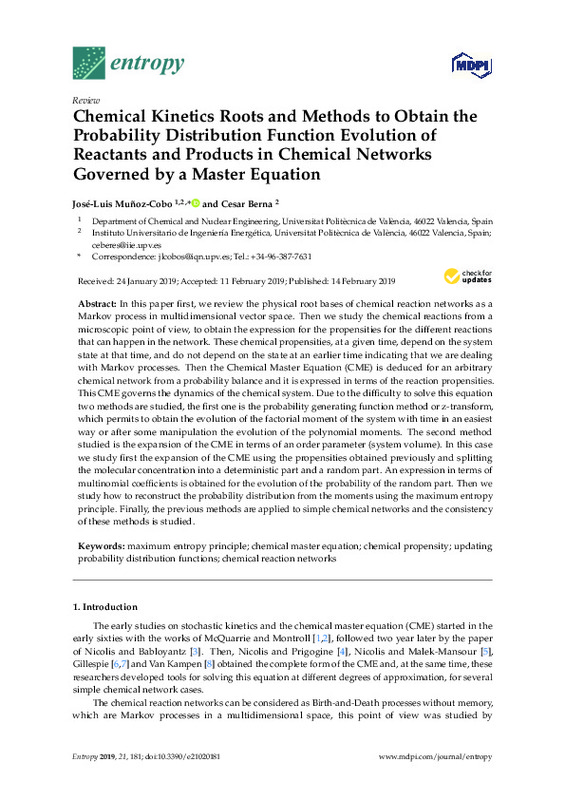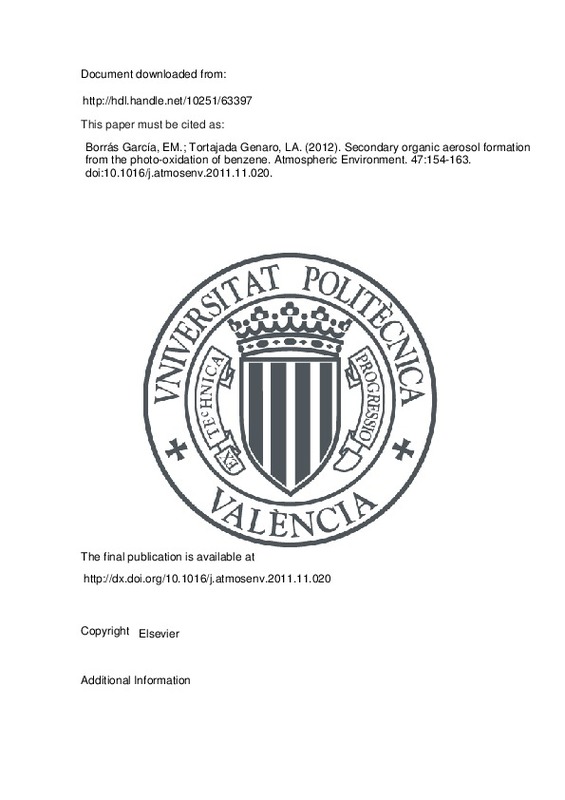McQuarrie, D. A. (1967). Stochastic approach to chemical kinetics. Journal of Applied Probability, 4(3), 413-478. doi:10.2307/3212214
Nicolis, G., & Babloyantz, A. (1969). Fluctuations in Open Systems. The Journal of Chemical Physics, 51(6), 2632-2637. doi:10.1063/1.1672388
Malek-Mansour, M., & Nicolis, G. (1975). A master equation description of local fluctuations. Journal of Statistical Physics, 13(3), 197-217. doi:10.1007/bf01012838
[+]
McQuarrie, D. A. (1967). Stochastic approach to chemical kinetics. Journal of Applied Probability, 4(3), 413-478. doi:10.2307/3212214
Nicolis, G., & Babloyantz, A. (1969). Fluctuations in Open Systems. The Journal of Chemical Physics, 51(6), 2632-2637. doi:10.1063/1.1672388
Malek-Mansour, M., & Nicolis, G. (1975). A master equation description of local fluctuations. Journal of Statistical Physics, 13(3), 197-217. doi:10.1007/bf01012838
Gillespie, D. T. (1992). A rigorous derivation of the chemical master equation. Physica A: Statistical Mechanics and its Applications, 188(1-3), 404-425. doi:10.1016/0378-4371(92)90283-v
Gillespie, D. T. (2007). Stochastic Simulation of Chemical Kinetics. Annual Review of Physical Chemistry, 58(1), 35-55. doi:10.1146/annurev.physchem.58.032806.104637
Salis, H., & Kaznessis, Y. (2005). Accurate hybrid stochastic simulation of a system of coupled chemical or biochemical reactions. The Journal of Chemical Physics, 122(5), 054103. doi:10.1063/1.1835951
Cao, Y., Gillespie, D. T., & Petzold, L. R. (2005). The slow-scale stochastic simulation algorithm. The Journal of Chemical Physics, 122(1), 014116. doi:10.1063/1.1824902
Munsky, B., & Khammash, M. (2006). The finite state projection algorithm for the solution of the chemical master equation. The Journal of Chemical Physics, 124(4), 044104. doi:10.1063/1.2145882
Smadbeck, P., & Kaznessis, Y. N. (2012). Efficient moment matrix generation for arbitrary chemical networks. Chemical Engineering Science, 84, 612-618. doi:10.1016/j.ces.2012.08.031
Sotiropoulos, V., & Kaznessis, Y. N. (2011). Analytical derivation of moment equations in stochastic chemical kinetics. Chemical Engineering Science, 66(3), 268-277. doi:10.1016/j.ces.2010.10.024
Gillespie, C. S. (2009). Moment-closure approximations for mass-action models. IET Systems Biology, 3(1), 52-58. doi:10.1049/iet-syb:20070031
Grima, R. (2012). A study of the accuracy of moment-closure approximations for stochastic chemical kinetics. The Journal of Chemical Physics, 136(15), 154105. doi:10.1063/1.3702848
Grima, R. (2015). Linear-noise approximation and the chemical master equation agree up to second-order moments for a class of chemical systems. Physical Review E, 92(4). doi:10.1103/physreve.92.042124
Grima, R. (2010). An effective rate equation approach to reaction kinetics in small volumes: Theory and application to biochemical reactions in nonequilibrium steady-state conditions. The Journal of Chemical Physics, 133(3), 035101. doi:10.1063/1.3454685
Schnoerr, D., Sanguinetti, G., & Grima, R. (2015). Comparison of different moment-closure approximations for stochastic chemical kinetics. The Journal of Chemical Physics, 143(18), 185101. doi:10.1063/1.4934990
Schnoerr, D., Sanguinetti, G., & Grima, R. (2017). Approximation and inference methods for stochastic biochemical kinetics—a tutorial review. Journal of Physics A: Mathematical and Theoretical, 50(9), 093001. doi:10.1088/1751-8121/aa54d9
Hasenauer, J., Wolf, V., Kazeroonian, A., & Theis, F. J. (2013). Method of conditional moments (MCM) for the Chemical Master Equation. Journal of Mathematical Biology, 69(3), 687-735. doi:10.1007/s00285-013-0711-5
Singh, A., & Hespanha, J. P. (2011). Approximate Moment Dynamics for Chemically Reacting Systems. IEEE Transactions on Automatic Control, 56(2), 414-418. doi:10.1109/tac.2010.2088631
Ruess, J., Milias-Argeitis, A., Summers, S., & Lygeros, J. (2011). Moment estimation for chemically reacting systems by extended Kalman filtering. The Journal of Chemical Physics, 135(16), 165102. doi:10.1063/1.3654135
Kazeroonian, A., Fröhlich, F., Raue, A., Theis, F. J., & Hasenauer, J. (2016). CERENA: ChEmical REaction Network Analyzer—A Toolbox for the Simulation and Analysis of Stochastic Chemical Kinetics. PLOS ONE, 11(1), e0146732. doi:10.1371/journal.pone.0146732
Shannon, C. E. (1948). A Mathematical Theory of Communication. Bell System Technical Journal, 27(3), 379-423. doi:10.1002/j.1538-7305.1948.tb01338.x
Shannon, C. E. (1948). A Mathematical Theory of Communication. Bell System Technical Journal, 27(4), 623-656. doi:10.1002/j.1538-7305.1948.tb00917.x
Jaynes, E. T. (1957). Information Theory and Statistical Mechanics. Physical Review, 106(4), 620-630. doi:10.1103/physrev.106.620
Jaynes, E. T. (1982). On the rationale of maximum-entropy methods. Proceedings of the IEEE, 70(9), 939-952. doi:10.1109/proc.1982.12425
Mead, L. R., & Papanicolaou, N. (1984). Maximum entropy in the problem of moments. Journal of Mathematical Physics, 25(8), 2404-2417. doi:10.1063/1.526446
Montroll, E. W., & Shlesinger, M. F. (1983). Maximum entropy formalism, fractals, scaling phenomena, and 1/f noise: A tale of tails. Journal of Statistical Physics, 32(2), 209-230. doi:10.1007/bf01012708
Shore, J., & Johnson, R. (1980). Axiomatic derivation of the principle of maximum entropy and the principle of minimum cross-entropy. IEEE Transactions on Information Theory, 26(1), 26-37. doi:10.1109/tit.1980.1056144
Muñoz-Cobo, J.-L., Mendizábal, R., Miquel, A., Berna, C., & Escrivá, A. (2017). Use of the Principles of Maximum Entropy and Maximum Relative Entropy for the Determination of Uncertain Parameter Distributions in Engineering Applications. Entropy, 19(9), 486. doi:10.3390/e19090486
Ruppeiner, G. (1995). Riemannian geometry in thermodynamic fluctuation theory. Reviews of Modern Physics, 67(3), 605-659. doi:10.1103/revmodphys.67.605
Gillespie, D. T., Petzold, L. R., & Seitaridou, E. (2014). Validity conditions for stochastic chemical kinetics in diffusion-limited systems. The Journal of Chemical Physics, 140(5), 054111. doi:10.1063/1.4863990
The chemical basis of morphogenesis. (1952). Philosophical Transactions of the Royal Society of London. Series B, Biological Sciences, 237(641), 37-72. doi:10.1098/rstb.1952.0012
Castets, V., Dulos, E., Boissonade, J., & De Kepper, P. (1990). Experimental evidence of a sustained standing Turing-type nonequilibrium chemical pattern. Physical Review Letters, 64(24), 2953-2956. doi:10.1103/physrevlett.64.2953
Maini, P. K., Painter, K. J., & Nguyen Phong Chau, H. (1997). Spatial pattern formation in chemical and biological systems. Journal of the Chemical Society, Faraday Transactions, 93(20), 3601-3610. doi:10.1039/a702602a
Ghosh, A., Leier, A., & Marquez-Lago, T. T. (2015). The Spatial Chemical Langevin Equation and Reaction Diffusion Master Equations: moments and qualitative solutions. Theoretical Biology and Medical Modelling, 12(1). doi:10.1186/s12976-015-0001-6
Samoilov, M. S., & Arkin, A. P. (2006). Deviant effects in molecular reaction pathways. Nature Biotechnology, 24(10), 1235-1240. doi:10.1038/nbt1253
Muoz-Cobo, J. L., Verdú, G., Jiménez, P., & Pea, J. (1986). Stimulated recombination in open systems. Physical Review A, 34(3), 2524-2527. doi:10.1103/physreva.34.2524
Grima, R., Schmidt, D. R., & Newman, T. J. (2012). Steady-state fluctuations of a genetic feedback loop: An exact solution. The Journal of Chemical Physics, 137(3), 035104. doi:10.1063/1.4736721
Laurenzi, I. J. (2000). An analytical solution of the stochastic master equation for reversible bimolecular reaction kinetics. The Journal of Chemical Physics, 113(8), 3315-3322. doi:10.1063/1.1287273
Woodbury, A. D. (2004). A FORTRAN program to produce minimum relative entropy distributions. Computers & Geosciences, 30(1), 131-138. doi:10.1016/j.cageo.2003.09.001
Caticha, A., & Preuss, R. (2004). Maximum entropy and Bayesian data analysis: Entropic prior distributions. Physical Review E, 70(4). doi:10.1103/physreve.70.046127
Cao, J. (2011). Michaelis−Menten Equation and Detailed Balance in Enzymatic Networks. The Journal of Physical Chemistry B, 115(18), 5493-5498. doi:10.1021/jp110924w
Choi, B., Rempala, G. A., & Kim, J. K. (2017). Beyond the Michaelis-Menten equation: Accurate and efficient estimation of enzyme kinetic parameters. Scientific Reports, 7(1). doi:10.1038/s41598-017-17072-z
Vlysidis, M., & Kaznessis, Y. (2018). On Differences between Deterministic and Stochastic Models of Chemical Reactions: Schlögl Solved with ZI-Closure. Entropy, 20(9), 678. doi:10.3390/e20090678
Gómez-Uribe, C. A., & Verghese, G. C. (2007). Mass fluctuation kinetics: Capturing stochastic effects in systems of chemical reactions through coupled mean-variance computations. The Journal of Chemical Physics, 126(2), 024109. doi:10.1063/1.2408422
Gibson, M. A., & Bruck, J. (2000). Efficient Exact Stochastic Simulation of Chemical Systems with Many Species and Many Channels. The Journal of Physical Chemistry A, 104(9), 1876-1889. doi:10.1021/jp993732q
[-]











